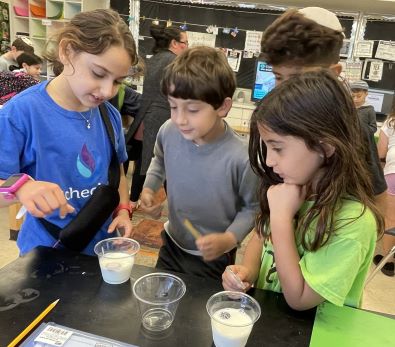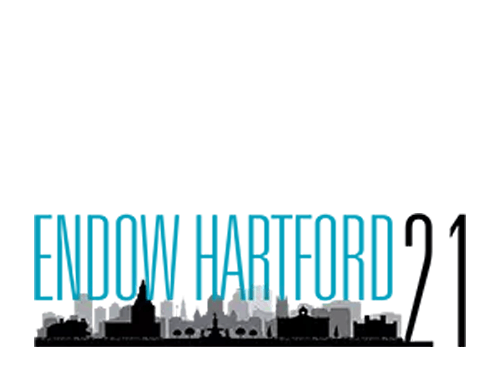Schechter Shavua: October 20, 2023
Two Year Olds Learn about Indigenous People
 The Nitzanimstudents (EC2) celebrated Indigenous Peoples Day by painting on “hides” made from paper grocery bags. First, the teachers read "Mama Do You Love Me?" by Barbara M. Joosse and "My Heart Fills With Happiness" by Monique Gray Smith, two books that feature characters and drawings depicting Indigenous People. Then, the students painted on crinkled-up grocery bags cut out to resemble the hides that Indigenous People sometimes use for artwork.
The Nitzanimstudents (EC2) celebrated Indigenous Peoples Day by painting on “hides” made from paper grocery bags. First, the teachers read "Mama Do You Love Me?" by Barbara M. Joosse and "My Heart Fills With Happiness" by Monique Gray Smith, two books that feature characters and drawings depicting Indigenous People. Then, the students painted on crinkled-up grocery bags cut out to resemble the hides that Indigenous People sometimes use for artwork.
What Cookies Can Teach about Scientific Method
 The Alimstudents (grades 3-4) have been getting their hands dirty (literally!), using hands-on experiments to learn about the process of the scientific method. First, they studied their fingerprints to practice asking questions, making observations, sharing hypotheses, conducting experiments, analyzing data, and stating conclusions. Then came “The Great Cookie Dunk,” in which students were given the testable question: “Do cookies float or sink in milk?” Despite great temptation, students fought back the urge to eat their experiment; they followed all the necessary steps of the scientific method in order to determine their conclusion. That was one big sacrifice for the sake of science!
The Alimstudents (grades 3-4) have been getting their hands dirty (literally!), using hands-on experiments to learn about the process of the scientific method. First, they studied their fingerprints to practice asking questions, making observations, sharing hypotheses, conducting experiments, analyzing data, and stating conclusions. Then came “The Great Cookie Dunk,” in which students were given the testable question: “Do cookies float or sink in milk?” Despite great temptation, students fought back the urge to eat their experiment; they followed all the necessary steps of the scientific method in order to determine their conclusion. That was one big sacrifice for the sake of science!
Click HEREfor more photos.
Alim (3rd) and Nevatim (5th) Students Receive Special Humashim
 Earlier this week, Schechter’s 3rd and 5th graders celebrated a special milestone: thanks to a generous gift from Brooke and Dr. Ronen Elefant, they received special new volumes of books of the Torah! The hardcover h umashim include Hebrew, an English translation, selections of classical commentaries, and deep open questions designed to provoke thought and conversations. After a beautiful and heartfelt shacharit service led by Avi Kay and Elliott Altenburger that filled the Beit Tefillah with prayer, third graders were given the book of Bereishit (Genesis), and fifth graders received Shemot(Exodus). The Elefants’ generous gift in memory of Ronen’s father was especially poignant due to the recent events in Israel.
Earlier this week, Schechter’s 3rd and 5th graders celebrated a special milestone: thanks to a generous gift from Brooke and Dr. Ronen Elefant, they received special new volumes of books of the Torah! The hardcover h umashim include Hebrew, an English translation, selections of classical commentaries, and deep open questions designed to provoke thought and conversations. After a beautiful and heartfelt shacharit service led by Avi Kay and Elliott Altenburger that filled the Beit Tefillah with prayer, third graders were given the book of Bereishit (Genesis), and fifth graders received Shemot(Exodus). The Elefants’ generous gift in memory of Ronen’s father was especially poignant due to the recent events in Israel.
Click HEREto see photos!
Parashat Noah—Seeing What Is, Not Just What We Want To See
 Some horrific, tragic news from Gaza this week—the explosion and resulting deaths at Ahli Arab Hospital—demonstrated the power of prejudice, with its core meaning of “pre-judging.” As the world learned about what happened, people mostly saw what they wanted to see. Initial reports and headlines jumped to the conclusion that Israel was responsible. As more evidence accumulated that Israel wasn’t at fault, responsible news organizations changed their headlines—but the damage to Israel’s image had been done.
Some horrific, tragic news from Gaza this week—the explosion and resulting deaths at Ahli Arab Hospital—demonstrated the power of prejudice, with its core meaning of “pre-judging.” As the world learned about what happened, people mostly saw what they wanted to see. Initial reports and headlines jumped to the conclusion that Israel was responsible. As more evidence accumulated that Israel wasn’t at fault, responsible news organizations changed their headlines—but the damage to Israel’s image had been done.
Obviously, this doesn’t just happen with Israel. “Confirmation bias” is the human tendency to focus on evidence that confirms our prior beliefs, and dismiss or ignore evidence that might call them into question. We tend to see what we want to see. Sometimes, it’s due to group stereotypes, and other times, to wishful thinking. Either way, it’s hard to overcome our tendency to see what we want to see.
Imagine that you were Noah on the ark; you’ve been trapped on board with your family and hordes of animals for almost a year. Only one question is on your mind: “How soon can I get off?!” You are probably desperate for a sign, any sign, that the land is dry and that it is safe to disembark.
Noah released a raven and then a dove to see if the land had dried; both initially returned with nothing. When he sent forth the dove again, she returned with an olive leaf in her beak. If I were Noah, just the sight of that leaf would have sent me running to open the hatches, no questions asked.
But as Hizkuni, a medieval French commentator, points out, it would have been reckless for Noah to leave the ark solely on the basis of a leaf. After all, floods cause tremendous amounts of debris, and floodwaters are never clean; the leaf could have been floating in the water while the trees were still submerged! Was he just jumping to conclusions, seeing what he wanted to see?
Hizkuni argues that Noah was actually incredibly perceptive. The Torah, in describing the leaf, says that it was “torn off in the dove’s beak”—torn from a tree and not snatched from the water. This detail told Noah that it was safe to leave the ark.
The broader lesson we can learn is about the importance of seeing what really is, and not just what we want to see. Noah was careful to look for a reliable sign; he was surely tempted to jump to conclusions, but he didn’t. May we too be blessed with clear vision, seeing what is and not just what we hope to see.
Shabbat shalom,
Rabbi Jonathan Berger
Head of School
Questions for the Shabbat table:
1. Imagine that you were on the ark with Noah. Besides evidence that it was safe to disembark, what would you most have wanted to see?
2. When have you found it challenging to see what is, instead of what you want to see?
Solomon Schechter Day School
of Greater Hartford
26 Buena Vista Road
West Hartford, CT 06107
© Solomon Schechter Day School of Greater Hartford | Site design Knowles Kreative




